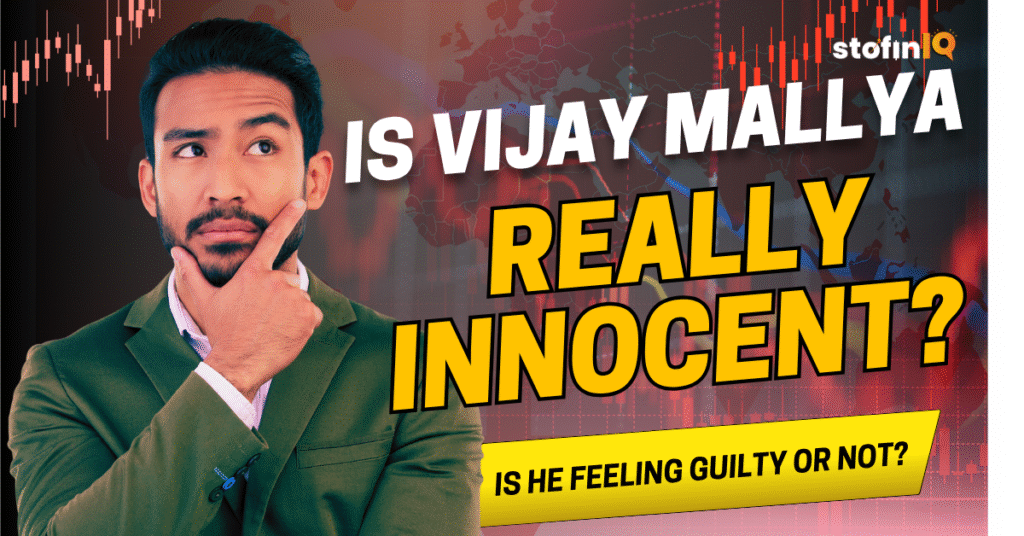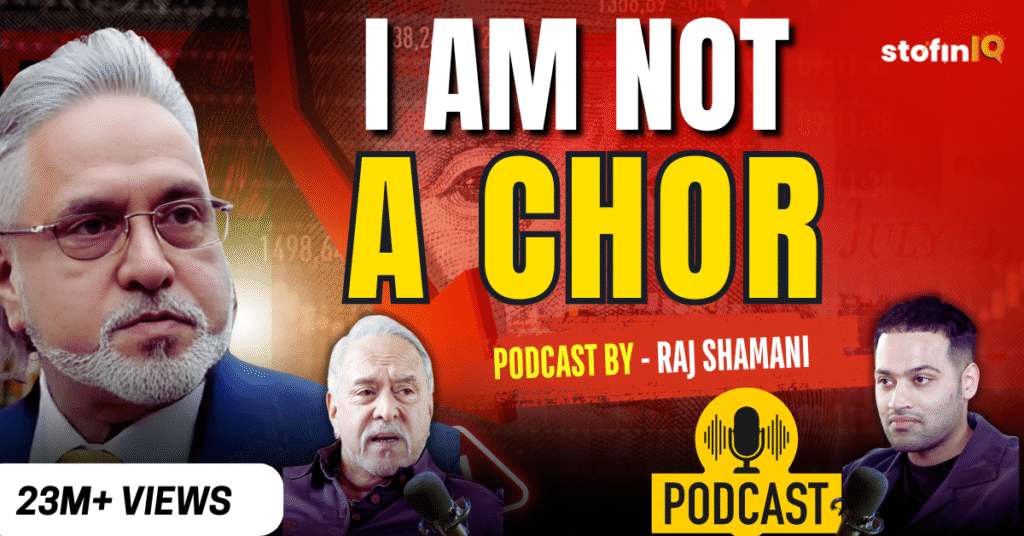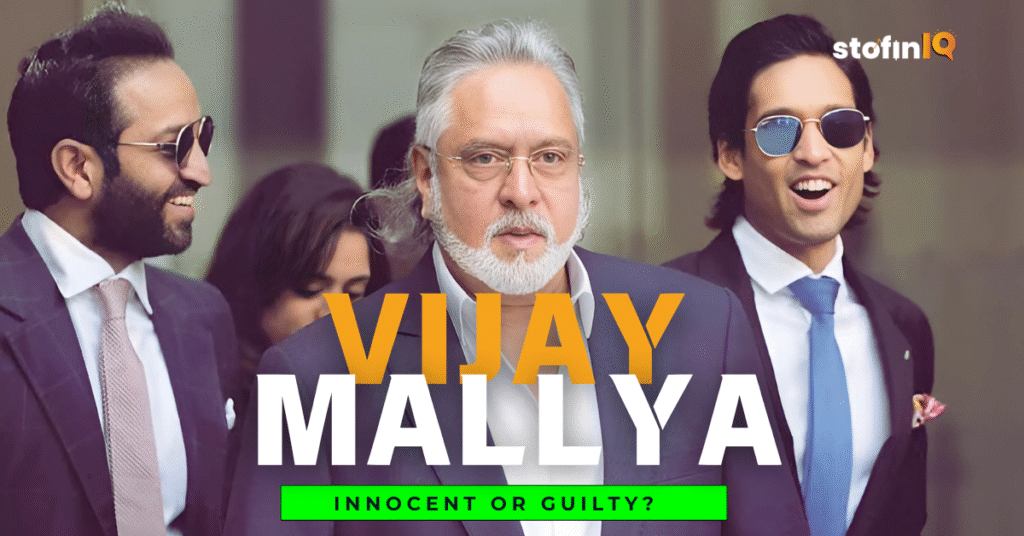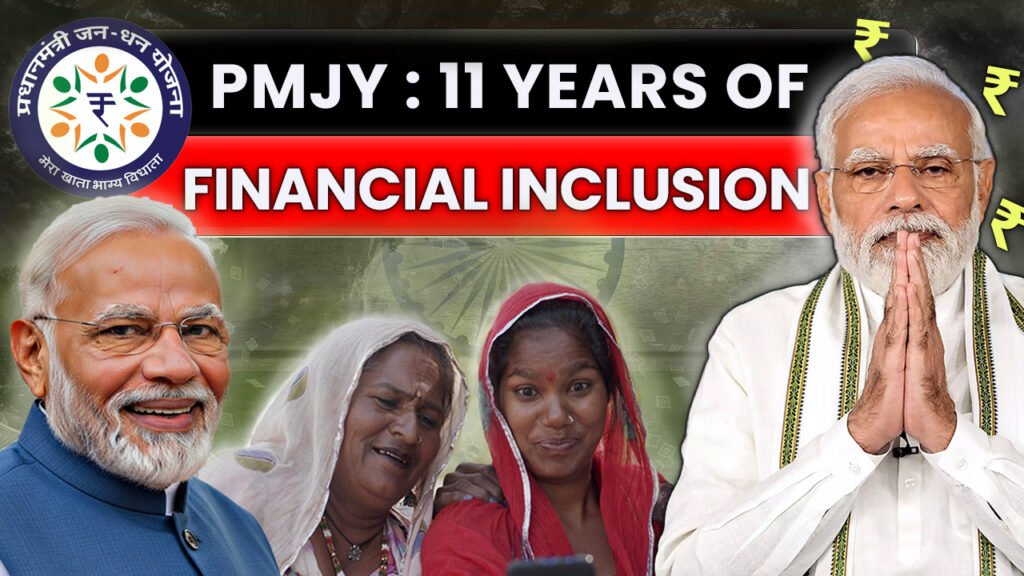
Vijay Mallya had been blinding India with his charismatic lifestyle and the flamboyancy of his branding, and his high-profile ventures. Mallya was born in Kolkata in 1995; his father, Vittal Mallya, was the head of United Breweries. Mallya ascended to the head of the Breweries and later the United Spirits before he became the visionary behind Kingfisher Airlines and the Formula 1 team Force India and acquired the IPL franchise Royal Challengers Bangalore (RCB)
But the tables turned in 2016 when his empire collapsed, and he left India. He has been avoiding media and attention, and after nine years, he resurfaced via a four-hour podcast with Raj Shamani to fight back
He claims to be innocent, but is he really innocent?
Let us find out:
Accusations Against Mallya: What Exactly Is Mallya Charged With?
It is important to note the premise of the main charges that have been put forward against Vijay Mallya before analysing his defence or media utterances. Among the biggest indictments is that of huge loan defaults.
A group of Indian banks accused Mallya of defaulting on loans to the tune of ₹6,203 crore through Kingfisher Airlines and other associated undertakings. It became ₹ 17,781 crore with accrued interest and penalties. According to The Economic Times data as of April 2025, approximately ₹10,815 crore was already recovered in one way or another, and approximately ₹6,997 crore remained to be recovered.
Source: www.economictimes.indiatimes.com
Besides the loan defaults, Mallya is alleged to have committed serious financial offences that feature money laundering and fraud. According to the Central Bureau of Investigation (CBI) and the Enforcement Directorate (ED), Mallya had misreported Kingfisher Airlines financials, channelled 423 crore for personal and unrelated business use, and overall laundered ₹3,547 crore through a complicated net worth of financial transactions.
Following these allegations and his flight out of India on March 2, 2016, the Indian government revoked the passport of Mallya and he was legally declared a fugitive economic offender under Indian law. This status also started extradition requests and contempt of court proceedings.
To add to his legal woes, a London court declared Vijay Mallya bankrupt in July 2021. This action was a result of failure to pay a judgement debt of 1.05 billion pounds which underlined the transnational character of his financial obligations.
Source: www.opindia.com
What is the Raj Shamani and Vijaya Mallya podcast about?

On 5 June 2025, Vijay Mallya appeared on the Figuring Out podcast with entrepreneur and content creator Raj Shamani in a much-publicised interview. Shamani is known to have a long-form style of interviewing business leaders, creators and public figures. His platform has become one of the most popular podcast formats in India– frequently celebrating change-makers by allowing them to give raw points of view. He went into a particularly controversial area by including Mallya.
It was the longest interview Mallya has given in almost ten years, since the charges against him, his side of the story of what happened to Kingfisher Airlines, and his present circumstances. The episode of the podcast was called “Vijay Mallya Unfiltered”, which indicated its purpose to tell the story of Mallya without putting it in the context of a court case or a media soundbite.
The viral effect of the episode was almost instant. It has already amassed over 20 million views on YouTube alone in merely four days, not to mention the untold thousands more who have seen it clipped on Instagram and X (formerly Twitter).
The announcement was met with scepticism, criticism, and intrigue by major media houses, financial analysts, influencers, and legal experts. The episode revived one of the most contentious financial arguments in India, with both Mallya’s proponents and critics offering caustic responses, as reported by Hindustan Times.
In the interview, Mallya was trying to rebrand his own image, portraying himself as a victim of politics and bad economic fortune, as opposed to intentional fraud. His voice was that of controlled outrage, and he often implied that he was the scapegoat of India after the nation’s crackdown on financial criminals after 2014.
Podcast link: https://youtu.be/MdeQMVBuGgY?si=IhUY-hgRW_R3AbhU
What Mallya Claimed: The Core Arguments
In his interview on the “Figuring Out” podcast, as well as in his earlier remarks, Vijay Mallya presented a set of fundamental arguments to justify his situation and refute the accusations pressed against him.
His efforts were to mix personal rationalisations with generalised attacks on the failures of institutions, such that he positioned himself not as a wilful defaulter but as a misunderstood entrepreneur, collateral damage in the crossfire between system dysfunction and political narratives.
One of the most unexpected of his statements was probably the following: “I am not a thief; I am a fugitive.” Mallya admitted that by remaining overseas he was in the (legal) fugitive category but strongly denied stealing government money.
He said that he had left India on March 2, 2016, not to escape justice but on a scheduled business trip. Well, you may call me a fugitive, if you like, but where is the chor?
He pointedly asked in the podcast, ‘Where is the chori?’, a line that soon took news sites and social media by storm. His voice had an element of outrage in it, as though being called a thief was a media-created exaggeration rather than a matter of law.
When it came to the financial magnitude of the claimed default, Mallya objected to numbers that frequently appeared in the media and investigation agencies. His contention was that the Debt Recovery Tribunal had recognised ₹6,203 crore as the principal amount of the loan and not the ₹9,000-10,000 crore that was being regularly bandied about.
He then swung into his most oft-repeated defence, the argument that over ₹14,100 crore had been recovered, a sum he claimed was more than twice the amount that was initially due.
This, according to Mallya, ought to put an end to the debate on his liability. He did not, however, differentiate between voluntary repayments and those ordered by the court to be recovered by seizure of assets, an oversight which has not gone unnoticed by critics.
The other key aspect in the story told by Mallya revolves around his so-called attempts to pay the debt. He states that he has formally offered to settle four times in the period 2012–2015 by giving personal guarantees and presenting compromise proposals.
According to him, the banks outright rejected these offers, and he accused the banks of being politically biased or lacking the desire to settle things amicably. His rhetoric implies that he has attempted cooperation but was driven into a legal corner through no fault of his own.
Defending himself against the issues of leading an extravagant life, Mallya was unapologetic. He claimed that his partying, luxury real estate holdings, expensive watches and other trappings of wealth were all financed through personal earnings or outside foreign business investments rather than bank loans. He alleged that not a rupee of the loan amounts was spent on personal indulgences. This aspect of his public persona, he painted as being demonised unnecessarily, as there should be no comparison between successful businessmen or successful traders using his own money and criminal activity.
Mallya provided an intricate mixture of economic explanations and political criticism when commenting on the bankruptcy of Kingfisher Airlines. His contention was that the airline did not fail because of poor management but because of systematic failures of the Indian aviation and policy environment.
He blamed this on the global financial crisis of 2008, the soaring taxes on aviation fuel, the ban on Foreign Direct Investment (FDI) in aviation then, and failure to undertake policy reforms on time. He went as far as saying that Finance Minister Pranab Mukherjee had advised him against shrinking the airline, indicating that political counselling had a role in the decisions that had turned against the company
The ardour of his voice, as he spoke this part of the interview, was one of frustration, not only with media critics but with the systemic impediments that enterprises had to contend with in India before 2014.
Lastly, Mallya comes close to the concept of going back to India, albeit with reservations. He made it clear that he did not have anything against standing up before the Indian legal system but must be given guarantees that he would get a fair trial and would be treated humanely. ‘I will consider it seriously,’ he answered, ‘if I have a guarantee of a fair trial and a decent
He has quoted findings of the High Court in the UK that had raised issues with conditions of detention in Indian prisons and stated that judgements such as these were the reason behind the delay in his extradition being effected.
His defence team has frequently used this legal aspect to stall extradition, indicating that Mallya has opted to bank significantly on a human rights plea, as opposed to solely legal or fiscal reasons.
Collectively, the defence presented by Mallya creates an image of a man who feels victimised, misjudged, and possibly persecuted. He contextualises his tale as that of institutional betrayal, media demonisation and dysfunctional political-economic systems, which all colluded, he says, to bring about the day crisis regarding his name.
Whereas Mallya portrayed himself as a victim of changing economic times, to a modern-day investor, the most important thing is to figure out those very changes, which our blog on how to start investing in 2025 decodes.
The Counterpoint: Fact-Checking Vijay Mallya’s Claims
Although Vijay Mallya gave a vehement defence in the “Figuring Out” podcast, most of his submission has been refuted by cold numbers, court verdicts, and investigative bodies. A more detailed look at the facts represents a much more complicated situation- one that contrasts with the story he told in public.
First of all, when Mallya speaks about the size of the loans, he frequently disregards the entire financial load that the banks had to take. Though he often refers to the original principal, approximately ₹6,848 crore as the sum under discussion, the liability had grown to ₹ 17,781 crore by April 2025.
This is the amount, which has been confirmed by the Debt Recovery Tribunal as well as the consortium of lending banks not only the principal amount but along with interest, penalties, and legal charges that have accumulated over a period of time. Of this amount, about ₹6,997 crore was still outstanding and ₹ 10,815 crore had already been recovered, as reported by The Economic Times. The defence of Mallya fails to represent the actual financial effect of the default, by omitting these other dues.
His other deceptive statement was that a sum amount of ₹ 14,000 crore has been recovered, and hence he ought not to be held liable any more. Although it is factual that assets to the tune of ₹ 14,131.6 crore have been retrieved, as acknowledged by several ministries, it is fallacious to suggest that such recoveries came because of personal action or compliance by Mallya himself.
Most of the recovery has been achieved in the form of court-ordered attachment of assets, auction sales and enforcement, and not as a result of Mallya making any voluntary repayment. A good number of these recoveries were effected several years after the default and in most cases, after protracted litigation.
Mallya further states he had offered to settle with the Indian banks, which according to him, had been declined. Nevertheless, as is stated in the sources related to the banking sector and according to the court filings, the announced settlements were not transparent, not clear, and did not have adequate guarantees.
According to the officials, his offers were too general to be a legal and financial liability and did not include interest on the complete liability. Therefore, the story of how a cooperative borrower is hounded by the institutions fails to pass the test of examination.
Among the many defences that Mallya has repeated the most is the fact that all his personal luxuries and lifestyle expenses were not funded through bank money. This is because he claims that his personal expenditure, which included buying yachts, mansions and partying, was funded by his other businesses or personal fortune.
But CBI and ED investigators disagree. They indicate in their reports that corporate loans have been channelled through shell entities and utilised in ways that are not in line with the professed business aims.
In certain instances, these funds were either re-appropriated or misreported as operating expenses when meeting non-related or luxury expenses. Although this may not have been used directly to buy personal assets, misuse of corporate loans ended up financing lifestyle elements indirectly aspect that courts and agencies have not been laughing at.
What concerns the collapse of Kingfisher Airlines, Mallya presents it as the sufferer of the adverse market conditions, such as increasing fuel prices and policy restrictions.
Admittedly, the aviation market had to deal with significant difficulties in the early 2010s, yet, according to industry analysts and critics, the downfall of Kingfisher was also profoundly entrenched in its ineffective financial planning, high operating expenses, and ineffective strategic choices.
Most prominent among them was the purchase of Air Deccan, a low-cost airline whose business model was very different. This acquisition was made without capital support or post-acquisition assimilations which even weakened the already vulnerable finances of Kingfisher and led it to its knees.
Last but not least, the legal status of Mallya is in sharp contrast to the one of the victims that he tried to portray. In July 2021, a London bankruptcy court ruled him insolvent, citing a lack of cooperation and repayment of Defaults. This judgement followed several years of Indian bank litigation and was a big blow to his legal credibility. Also, although he denied having fled India, it is on record that he departed only days before the Indian authorities acted.
He had been sought on extradition requests which were pursued aggressively, and despite UK courts ordering extradition, Mallya as of early 2025 was still in the United Kingdom availing of the advantages of legal technicalities and delays in the execution of the final order. He was also convicted of contempt of court by the Indian Supreme Court, becoming the second Prime Minister to do so after Indira Gandhi.
In conclusion, although the interview of Vijay Mallya attempted to rewrite the narrative in the minds of the people regarding his case, an analytical examination of the financial documents, court case, and investigative reports shows that his defence has many gaps. His image of an unapprehended businessman besieged by a vindictive system cannot stand up to facts when measured against what is known and recorded and official reactions.
Verdict: Innocent or Guilty? The Balanced View

The story that Mallya has put across portrays him as a victim- misinterpreted, besieged, and arm-twisted. He collectively makes good points regarding media amplification, bureaucracy, and policy failures. Part of the money that has been retrieved indicates mismanagement of assets.
But the heaviness of the legal decisions, of tribunals, courts, and regulatory bodies, and documentary evidence, indicate misgovernance, deliberate default, and theft in the corporations. His defence sounds good optically but is lesser in the legal realities.
He has not been acquitted by any court in India; he is considered guilty by a UK bankruptcy court, and extradition is yet to be accomplished to confirm that his legal woes are not over.
Final Thoughts: What This Means for Us
- Mallya’s podcast is a calculated masterclass in narrative control—calm, articulate, and media-savvy.
- Raj Shamani offered a polished platform, but can’t sidestep legal verdicts or detailed financial data.
- Mallya’s plea for a “fair trial” suggests a possible return, but only time—and court rulings—will reveal outcomes.
In public opinion, the division remains stark: some view him as a scapegoat; others see an unpunished corporate defaulter. What is undeniable: this saga remains a potent cautionary tale of ambition, hubris, and accountability in India’s corporate landscape.
Conclusion:
- The podcast by Mallya is a masterclass in the control of the narrative which is calm, articulate, and media-savvy.
- Raj Shamani provided a slick platform, however, cannot avoid legal decisions or financial statistics.
- The fact that Mallya is asking to be given a fair trial implies that he may come back, although only time (and judicial decisions) will tell us anything.
- The split is still sharp in the minds of the people: there are those who believe him to be a scapegoat; there are those who believe he is an unpunished corporate defaulter. What cannot be rejected: this is an impressive cautionary tale of ambition, hubris, and responsibility in the Indian business environment.
Congratulations on reaching the end of this in-depth expose!
You must be a financial explorer: a person who believes in truth, context, and a more insightful view of the business world.
To further your finance, business strategy, stock market, mutual funds, crypto, and other journey- follow StofinIQ We decode complex financial stories and trends and present them in an easy-to-understand, informative, and actionable manner.
Stay curious. Stay informed. Be in the know with – StofinIQ
I left my engineering job to follow my true passion writing and research. A passionate explorer of words and knowledge, I find joy in diving deep into topics and turning rich, insightful research into compelling, impactful content. Whether it’s storytelling, technical writing, or brand narratives, I believe that the right words can make a real difference.

